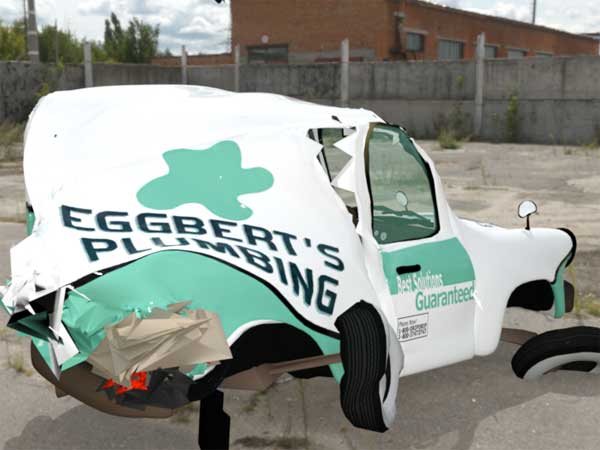Safety is paramount when it comes to choosing a van, whether you're using it for commercial purposes or personal needs. Modern vans are now equipped with a suite of safety technologies, many of which were once reserved for high-end cars. They include:
Autonomous Emergency Braking (AEB)
Autonomous Emergency Braking, often abbreviated as AEB, is a safety feature that has become increasingly standard in the van market. AEB uses sensors and cameras to monitor the road ahead and can apply the brakes automatically if it detects an imminent collision.
Ford's Transit Custom, for example, comes with Pre-Collision Assist with Pedestrian Detection, an advanced AEB system that can detect both vehicles and pedestrians. Volkswagen's Transporter T6.1, meanwhile, offers Front Assist with City Emergency Braking, an AEB system that works particularly well in slow, city traffic.
Electronic Stability Control (ESC)
Electronic Stability Control, or ESC, is a safety technology designed to help drivers maintain control of their vehicle during extreme steering manoeuvres. It detects loss of steering control and automatically applies the brakes to individual wheels to help "steer" the vehicle where the driver intends to go.
ESC is particularly helpful in vans, which owing to their size and weight distribution, can be prone to skidding or even rolling over. Many modern UK vans, such as the Mercedes-Benz Sprinter and the Peugeot Boxer, come equipped with ESC as standard.
Lane Keeping Assist
Lane Keeping Assist is a safety feature that can help prevent accidents caused by unintentional lane departures. It uses cameras to monitor lane markings and can alert the driver or even steer the vehicle back into it's lane if it detects that the van is drifting without the indicator being used.
Ford's Transit series features a Lane Keeping Alert and Lane Keeping Aid system, which not only warns the driver with vibrations in the steering wheel but can also apply torque to guide the van back into it's lane. The Renault Trafic also comes with a Lane Departure Warning system, further exemplifying the adoption of this technology in the van segment.
Blind Spot Assist
Blind Spot Assist uses sensors to monitor areas that the driver may not be able to see easily. If it detects a vehicle in the van's blind spot, it can alert the driver, typically with a visual warning in the side mirror. Some systems can even intervene by steering the van back into it's lane if the driver ignores the warning and tries to change lanes.
This feature is particularly useful in vans, which often have larger blind spots than cars. The Mercedes-Benz Sprinter offers an Active Lane Keeping Assist system, which combines Blind Spot Assist with Lane Keeping Assist for enhanced safety. The Vauxhall Vivaro also offers a Side Blind-Spot Alert system, providing additional peace of mind.
Driver Alert Systems
Driving long hours, which is common in van usage, can lead to fatigue and a loss of concentration. To combat this, many modern vans come equipped with Driver Alert Systems. These systems monitor the driver's behaviour, such as steering patterns, and can issue a warning if they detect signs of drowsiness or inattention.
For example, Volkswagen's Crafter includes a Driver Alert System that detects deviations from normal steering patterns and recommends breaks when it identifies driver fatigue. Similarly, the Ford Transit uses data from the Lane Keeping System to detect signs of tiredness, underscoring the intertwined nature of these safety technologies.

Rearview Cameras and Parking Sensors
Given their size and the often limited rear visibility, reversing and parking vans can be a challenging task. To aid drivers, most modern vans are equipped with rearview cameras and parking sensors. These systems provide visual and auditory assistance, making it easier to manoeuvre the van in tight spaces without risking damage or accidents.
For instance, the Mercedes-Benz Vito provides a reversing camera that displays it's image in the rear-view mirror, giving you a clear view of what's behind. Likewise, the Ford Transit Custom features a Rear View Camera Pack that includes a Downlighter, illuminating the area behind the van at night, a useful feature given the varied working hours of many van drivers.
Crosswind Assist
Crosswind Assist is a safety feature specifically tailored for high-sided vehicles like vans. It helps the vehicle maintain it's lane during strong crosswinds by automatically applying brakes to individual wheels. This feature is incredibly beneficial for van drivers who frequently travel on open roads or in inclement weather.
The Mercedes-Benz Sprinter features Crosswind Assist as a standard safety feature. Similarly, the Volkswagen Crafter's Crosswind Assist uses sensors to detect wind gusts and helps the driver stay in the lane.
Adaptive Cruise Control
Adaptive Cruise Control (ACC) is a feature that not only maintains a set speed, like traditional cruise control, but also adjusts the speed to keep a safe distance from the vehicle in front. This feature is particularly useful for long drives on motorways, reducing driver fatigue and improving safety.
The Ford Transit Custom's Intelligent Adaptive Cruise Control adjusts speed based on traffic conditions, and even includes Traffic Sign Recognition to adjust the set speed to match changing speed limits. Volkswagen's Transporter T6.1 also offers ACC, ensuring both comfort and safety during long trips.
Traffic Sign Recognition
Traffic Sign Recognition systems use cameras to identify traffic signs and display them on the vehicle's dashboard. This feature can help drivers adhere to speed limits and be aware of other road conditions, especially in unfamiliar areas.
The Vauxhall Vivaro, for instance, includes a Speed Limit Recognition System, which can recognise and display speed limits and no-passing signs, aiding the driver in maintaining a lawful and safe speed.
Advanced Lighting Systems
Advanced lighting systems, including automatic headlights and high-beam assist, are becoming standard features in modern vans. These systems can automatically switch between high and low beams depending on oncoming traffic, improving visibility and reducing the risk of blinding other drivers.
The Citroen Relay offers an Intelligent Beam Headlights system, which automatically switches between high and low beams. The Ford Transit Custom also features Auto High Beam, which temporarily dips the high beams when it detects oncoming traffic or a vehicle ahead.
In conclusion, modern UK vans are equipped with an impressive array of safety features, transforming them from mere cargo carriers to high-tech mobile workplaces prioritising driver safety. From technologies that assist in driving and parking to systems that actively work to prevent collisions, these features are contributing to a significant reduction in the number of accidents involving vans. As a potential van owner, understanding these safety features will help you make an informed decision, ensuring that you not only have a van fit for purpose, but one that offers maximum protection on the road.

